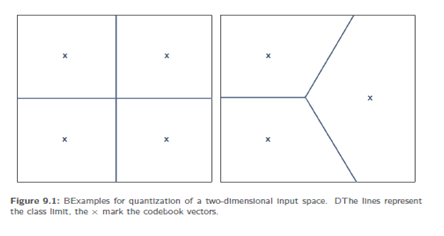Quantization
Introduction:-Quantizationis also referred to as discretization. We know the sequence of discretenumbersN = {1, 2, 3. . .}, which contains the natural numbers. Discrete means, that this sequence consists of separated elements that are not interconnected. The elements of our example areexactly such numbers, because the natural numbers do not include, for example, numbers between 1 and 2. On the other hand, the sequence of real numbers R, for instance, iscontinuous: It does not matter how close two selected numbers are, there will always be a number between them.
Quantization means that a continuous space is divided into discrete sections: By deleting, for example, all decimal places of the real number 2.71828, it could be assigned to the natural number 2. Here it is obvious that any other number having a 2 in front of the comma would also be assigned to the natural number 2, i.e.2 would be some kind of representativefor all real numbers within the interval. It must be noted that a sequence can be irregularly quantized, too: For instance, the timeline for a week could be quantized into working days and weekend. A special case of quantization is digitization: In case of digitization we alwaystalk about regular quantization of a continuous space into a number system with respect to a certain basis.
(Quantization). Separation of a continuous space into discrete sections.
(Digitization). Regular quantization.
LVQ divides the input space into separate areas: -A set of representatives should be used to divide an input spaceinto classes that reflect the input space as well as possible. Thus, each element of the input space should be assigned to a vector as a representative, i.e. to a class, where the set of these representatives should represent the entire input space as precisely as possible. Such a vector is called codebook vector. A codebook vector is the representative of exactly those input space vectors lying closest to it, which divides the input space into the said discrete areas. It is to be emphasized that we have to know in advance how many classes we have and which training sample belongs to which class. Furthermore, it is important that the classes must not be disjoint, which means they may overlap. Such separation of data into classes is interesting for many problems for which it is useful to explore only some characteristic representatives instead of the possibly huge set of all vectors be it because it is less time-consuming or because it is sufficiently precise.

The use of a prepared set of codebook vectors is very simple: For an input vector ythe class association is easily decided by considering which codebook vector is the closest – so, the codebook vectors build a voronoi diagram out of the set. Sinceeach codebook vector can clearly be associated to a class, each input vector is associated to a class, too.